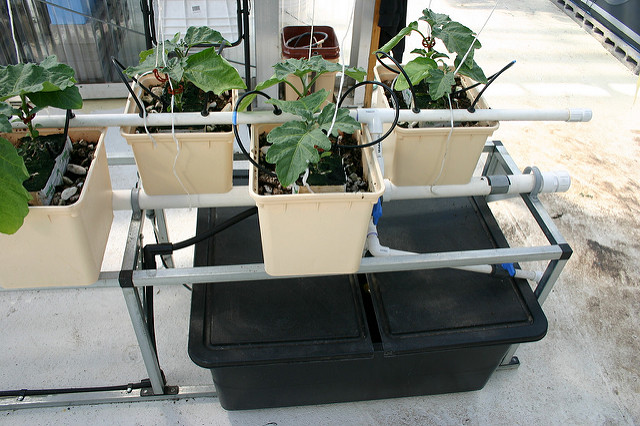This is Page 7 of our eight page series on flood and drain systems. Click any of the below pages to jump to that page.
Page 1 Page 2 Page 3 Page 4 Page 5 Page 6 Page 7 Page 8
Flood and Drain Systems, continued

Look closely and you'll see some interesting details in this flood and drain system picture. First, notice that the plants themselves are growing in large rockwool cubes, which then rest directly on top of either lava rock or large gravel. This hybrid approach is a wonderful way to make best use of different growing media advantages within a single system. This also allows for plants to easily be germinated and/or transplanted within a flood and drain system. Finally, notice that with the use of individual containers, these plants can be moved into and out of the system without disturbing the surrounding plants. For growers who know they want to germinate and/or transplant into or out of flood and drain systems, some creativity like the above setup can provide the best of all worlds.
Can Crops Be Germinated In This System?
Just for the sake of thoroughness, we'll address this topic here even though we already touched on it previously. Ebb and flow systems can be used to germinate seeds, but it must be done with a few caveats in place. First, the size of the seed as well as the crop's fate will dictate what sort of growing media needs to be used. If the seed is small and/or the plants are scheduled to be removed from the container to be planted elsewhere, then plant each seed into a rockwool cube, and embed the cubes in a growing medium which will easily allow them to be removed later. Sand, gravel and hydroton would all be good choices. Coir could be used but the transplantation would probably pull some coir along with it.
Secondly, the irrigation cycle would have to be carefully calibrated to raise the water level just high enough to moisten the seed, but not high enough to lift it out of the growing medium, pull it down deeper into the medium, and/or carry it off down the drain. The smaller the seed, the higher a priority this becomes. For large, fast-germinating seeds such as squash, it is unlikely this will be a problem.
If those two caveats are addressed, then flood and drain systems can be a very good germination option.
Can Crops Be Transplanted Into This System?
The short answer is yes. Use a growing medium that is easy to rearrange to make room for, and then suitably anchor the transplants. Most of the common growing media are sufficient for that purpose; lava rock is the one growing medium which would be difficult to work with in this context. Hydroton might be a little annoying to work with but its other advantages may outweigh that hassle.
One interesting possibility with this system, is to use a combo of plants in pots, within a growing container. So for instance, pot up a dozen tomatoes into 1 gallon containers, using whatever growing media (or soil) you deem best. Then, put the pots side by side into a suitably sized container. The container can then use the flood-and-drain cycle, which will moisten and then drain each of the pots. The pots themselves will hold the growing media. This sort of hybrid system can also be used if the crop is due to be sold later as living plants.
Helpful Hints
Here are some helpful hints, "words from the wise", and lessons learned the hard way, related to ebb and flow system design, operation and maintenance:
- If building this system in an apartment or area at risk from drips, locate the reservoir directly underneath the growing beds to catch any drips. Alternately, put a small gutter all the way around the growing beds and have those empty back into the reservoir.
- The overflow tube should be a bit lower than the lip of the growing tray, to prevent overflow of the growing tray.
- If using a timer to control the pump, a digital timer will allow for more precise pump operation.
- Make sure the growing tray(s) is/are level, so that each plant gets the same amount of nutrient solution.
- If using a large flood tray, locate the overflow tube as far from the inlet as possible, so that nutrient solution will circulate throughout the tray before draining.
- Avoid using transparent containers, because that promotes the growth of algae along the sides and bottom, which will use up dissolved oxygen and eventually clog the tubing.
- When designing the drain, leave a small reservoir of nutrient solution in the bottom of the planting tray. That way if the pump fails, there will still be an emergency supply of water to buy some time.
- Small seeded plants should be germinated elsewhere until well rooted, so that they don't float away with the irrigation cycle.
Click any of the below links to jump to that page.